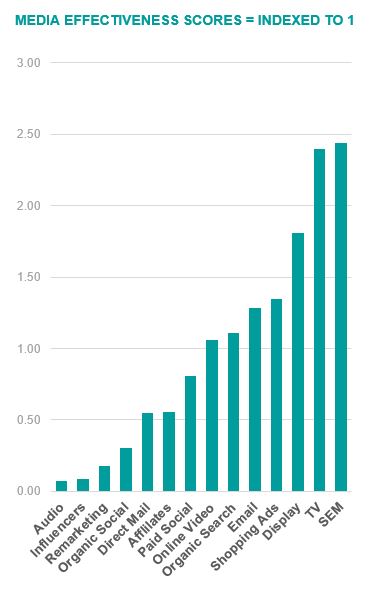Optimizing media now and entering into the recovery period
AUTHOR: ROBERT CARDARELLI, SVP AT IPSOS MMA
Download the PDF of this Article >
With the outbreak of novel coronavirus (COVID-19), marketers and media planners are wrestling to understand how to navigate these turbulent waters. Successful marketers during this crisis must think and act in an agile manner while taking advantage of data, predictive analytics while at the same time learning from the past by leveraging available benchmarks from historical economically challenged events. Challenging times can be defining moments. While full of risk they often present material opportunities for companies who recognize that, in a world that is growing by a billion-plus people every 10-or-so years, that these seemingly apocalyptic moments are, in the grand scheme of things, fleeting in historic and economic terms.
2020 is shaping up to be one of the most challenging years in recent times for marketers. COVID-19, the oil crisis, questions around the upcoming Olympics, the U.S. election – all are reshaping how businesses and marketers need to think about their brands in the short and long-term. Not only to make numbers but in some cases, to simply stay in business long-term. Never have data-informed analytics been more important. Those who have the combination of data, analytics, flexibility, leadership and ability to execute to the optimal answers quickly will not only be able to navigate their organization through this period, but also set-up their brands for an expedited recovery as well as marketplace advantages. For 30+ years, through good times and bad, MMA has collected marketplace norms and benchmarks across industries and globally. From the great bull market that just ended to the small recessions in the early 1990’s and 2001 all the way to the Great Recession of 2008/2009 and 9/11, we have compiled a range of historical brand actions – good, bad and ugly. From this we have developed an informed perspective from which we can make recommendations that can better educate brands to help them successfully work their way through these turbulent waters. In our experience, those companies that quickly address the current situation for what it is, and then shift gears toward solving for the business problems at hand, will be considerably more successful than those who are paralyzed and linger too long in contemplating the situation itself.
-
MAINTAIN BRAND EQUITY THROUGH EFFICIENT MEDIA CONTINUITY
Historical Ipsos MMA benchmarks demonstrate that brands that maintain a minimum to moderate level of media continuity during recessionary times tend to gain share of voice and market share. They also recover faster as well as outperform competition over the following one to two years. We have seen in many of those cases that an increase in share of voice often leads to category leadership and growth in revenue and profits in the recovery period. Important enabling factors include optimizing the marketing budget to achieve a balance between branded media vs. promotions, including identifying minimum weekly thresholds by media channel. Our data has indicated that many brands that significantly cut brand media investments, or “go dark”, pay a price, sacrificing brand equity in the long-term while raising the cost of doing business through an increased consumer reliance on promotions and discounting. An over-reliance on price and promotion has been shown to compromise long-term brand health as well as risk the compression of brand hierarchies – something we’ve seen happen in a material way since the 2008/2009 recession. Often brands that have sacrificed brand building equity marketing find their promotion budgets skyrocketing while brand health and market share decline. Too often by the time there is a recognition of the impact, the cost of rebuilding brand equity is multiples higher than the historical budget. So, as a popular adage says, “When times are good you should advertise. When times are bad you must advertise.”
-
TAKE ADVANTAGE OF SHIFTS IN MEDIA ENGAGEMENT AND VIEWERSHIP AS CONSUMERS ARE AT HOME
During challenging and disruptive periods, we’ve seen significant shifts in viewership across programming and devices. In today’s environment we are already seeing significant shifts from mobile viewership to TV and Desktop as consumers are staying and working at home. In addition to shifts in TV, there are opportunities for advertisers to re-think their contextual advertising strategy and closely manage and optimize this strategy on a weekly basis as the situation evolves. People are obsessively online reading about health issues, forecasts, travel alerts, news reports, and global markets. Advertisers can use this information to build the right contextual placements and consider the right real time attribution approaches to understand how contextual advertising is working. Advertisers can also use contextual data to drive what insights they can glean about how their ads should match the right context: what works, what doesn’t, where they need to be. AI-based learning is available to not only measure the impact of contextual, but also to drive the right creative message in addition to where and what partners to utilize in order to make brands a part of the conversation in a positive manner.
Flexibility in the Programmatic Space also represents a significant opportunity for advertisers. In times of high volatility, programmatic media is an effective lever for driving mid to low funnel targeting and short-term sales through e-commerce and owned channels. Programmatic technologies enable efficiencies through agility. With these technologies, brands and their agency partners can turn campaigns on and off, directly targeting optimal customer segments. This enables them to optimize ROI and their campaigns in-real time.
-
RAPID RE-OPTIMIZATION OF MARKETING AND MEDIA INVESTMENTS DURING THE PERIOD OF DISRUPTION AND UNCERTAINTY
Advertisers are challenged to balance the need for cost management while seeking to address new opportunities during periods of disruption and uncertainty. There are many decisions to be made with new and varying options changing on a daily basis. While sponsorships, national and local event investments are now less viable, during periods such as this, ad rates tend to drop resulting in a “buyers-market” for them. Taking advantage of this “buyers-market” requires flexibility as there are many constraints across the media landscape as well as a significant shift in how, when and where consumers engage with media. With no pure mathematical optimization or algorithm available during this time period, in order to build an optimal media plan, a combination of holistic marketing mix models, integrated digital data, and cross-industry media benchmarks is required. A unified approach combined with collaboration across advertisers and their agencies is necessary. These teams need to achieve cross-functional alignment on assumptions related to non-marketing factors such as: pricing, distribution, products/services, economic factors and competition as inputs into the marketing optimization scenarios in order to be successful.

-
SHIFT FOCUS TO DRIVE CONSUMER BEHAVIOR THROUGH OWNED AND ECOMMERCE CHANNELS
As people are limited in their “trip types”, incorporating a balanced media plan that optimizes commerce growth is important. This is an opportunity to accelerate DTC sales strategies that may have been underperforming and underinvested. By balancing media optimization objectives to drive e-commerce, online ordering and owned channel growth marketers are able to quickly and in an agile manner shift consumer demand and conversion across these channels. Based on MMA’s marketing ROI benchmark database across brands in the apparel, retail, QSR, durable goods, financial services, consumer electronics and pharmaceutical verticals we see the following themes emerge:
- TV and Search are still the strongest drivers of sales across e-commerce – as we see across multiple models, there is a strong interaction effect
- Orchestrate linear TV with online video to bolster brand presence. Video consumption is up and targeting through platforms such as OTT are crucial
- Display media is important as it provides the opportunity for more focused audience led and contextual targeting as well as frequency management and customer journey optimization
- Email is ranked high as it provides the opportunity to drive personalized communications and offers. This is important given the daily changes in the marketplace, such as limited inventory, logistics, news events, social distancing, etc.
- Results suggest that while lower funnel tactics such as remarketing, affiliates, etc. work they should be evaluated as brands have an opportunity to drive brand campaigns coupled with search media (SEM, PLA, etc.) to stay relevant and drive conversion.
-
DEVELOP “BACK TO BUSINESS” SCENARIOS TO ACCELERATE BUSINESS PERFORMANCE IN THE BACK-HALF OF 2020
 The long-term impact of the COVID-19 virus is yet unknown. That said, we are able to develop “what-if” scenarios based on assumptions related to the timing of the impact and when we might get back to business-as-usual, or at least more-like-usual. Using this information, executives have the opportunity to quickly adjust plans to create ‘best scenario’ plans during this period of uncertainty, and then work together to ‘war game’ in order to accelerate plans to make up deficits as things trend in a more positive direction. We recognize that there are many influencing variables during this period of uncertainty, including: duration and intensity of the impact of COVID-19, economic factors, business trends and behaviors, marketing activities, pricing and promotion, operations (distribution, product, service, etc.) and consumer attitudes. By leveraging real-time, data-informed insights in a unified manner companies will be able to build more flexible and forward-looking business simulations to adjust to the new customer attitude and business conditions. This creates a powerful capability to manage sales, profit and business KPIs not only for the future, but during this period of uncertainty.
The long-term impact of the COVID-19 virus is yet unknown. That said, we are able to develop “what-if” scenarios based on assumptions related to the timing of the impact and when we might get back to business-as-usual, or at least more-like-usual. Using this information, executives have the opportunity to quickly adjust plans to create ‘best scenario’ plans during this period of uncertainty, and then work together to ‘war game’ in order to accelerate plans to make up deficits as things trend in a more positive direction. We recognize that there are many influencing variables during this period of uncertainty, including: duration and intensity of the impact of COVID-19, economic factors, business trends and behaviors, marketing activities, pricing and promotion, operations (distribution, product, service, etc.) and consumer attitudes. By leveraging real-time, data-informed insights in a unified manner companies will be able to build more flexible and forward-looking business simulations to adjust to the new customer attitude and business conditions. This creates a powerful capability to manage sales, profit and business KPIs not only for the future, but during this period of uncertainty.



